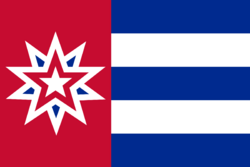| República Popular De Las Antillas | |
|---|---|
| People's Republic of the Antilles | |
| Flag of the Antilles | |
| General | |
| Name | People's Republic of the Antilles |
| Capital City | Holguín |
| Largest City | Santiago De Los Caballeros |
| National Abstract | |
| Government | |
| Government Type | Unitary Presidential Dictatorship |
| Head of State | President Rául Calvillo |
| Demographics | |
| Demonym | Antillano |
| Population | 1,659,000 |
| Spoken Language(s) | Spanish, French, English |
| Ethnic Groups | Cubans, Dominicans, Haitians, Bahamians |
| Major Religions | Catholicism, Protestantism |
The People's Republic of the Antilles is a nominally communist state in Central America, while in practice being ran as a presidental dictatorship with some socialist elements. The country is composed of the Eastern Cuban Archipelago and the former Dominican Republic, which contains the country's largest city, Santiago De Los Caballeros.
History[edit | edit source]
The Flood claimed a large amount of Cuba's landmass, including three of its five largest cities: Havana, Santiago De Cuba, and Guantanamo. Tracts of arable farmland were swallowed by the sea, placing further strain on Cuba's inefficient agricultural industry, which already produced less than 30% of Cuba's food. In 2034, troops of the Cuban Fuerzas Armadas Revolucionarias invaded the nearby Dominican Republic, seeking to use its vast agricultural potential to alleviate the food crisis in Cuba, as well as seize its reserves of currency and capital to fund the importation of food from mainland Latin America. Cuban Mig-23's knocked out the limited Dominican air force in a raid against San Isidros Air Base, and Cuban airborne troops quickly captured the interim capital of Santiago De Los Caballeros, with a larger complement of Cuban marines and infantry landing later to fully occupy the country.
Military occupation of the Dominican Republic lasted 17 months, until in November 2035 it was incorporated into Cuba as a partner in the new People's Republic of the Antilles. However, despite these efforts, the loss of vital infrastructure during the Flood, and the cessation of oil shipments from the communist government of Venezuela, now in collapse, made Cuba, now the Antilles, unable to keep the same standards of public spending as it had prior to the Flood. Successive presidents chipped away at the social safety net of Cuba, as well as implementing new laws to further curb the power of the democratic elements of the government, centralising power in the hands of the President and a select few Party officials.
Government[edit | edit source]
The President and First Secretary of the Partido Comunista Antillano is currently Rául Calvillo.
Due to the erosion of any semblance of Antillean democracy, the President rules with absolute power, with the elected National Assembly of People's Power acting in a purely advisory role. As the Partido Comunista Antillano is the only legal political party, as long as the President maintains the support of the rest of the Party leadership, they are effectively dictator for life.
Economy[edit | edit source]
Following the loss of large amounts of manufacturing capability, and developed arable land, the Antillano economy was forced to change to compensate for this. Due to the destruction of these facilities as well as roads and railways across the country, processing and refining facilities for its major agricultural exports - sugar, coffee, and tobacco - had to be moved closer to their source. To aid this, the Antillano government encouraged the establishment of new "agricultural communes," clearing away forests to allow for new agriculture to be established in the formerly less-inhabited inland regions of Cuba and Hispaniola.
While the secondary sector of the Antillano economy has failed to recover to pre-Flood levels, the Holguín government has attempted to offer subsidies and grants for the establishment of new industry and processing plants, with little success.
